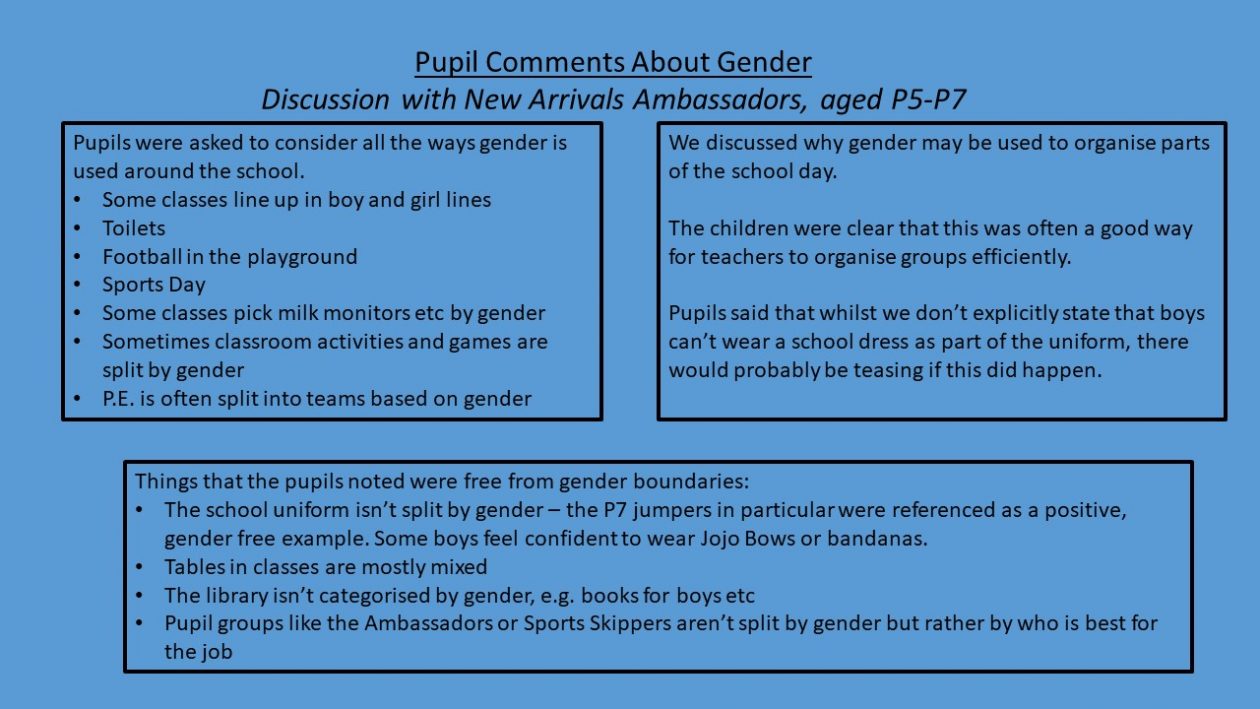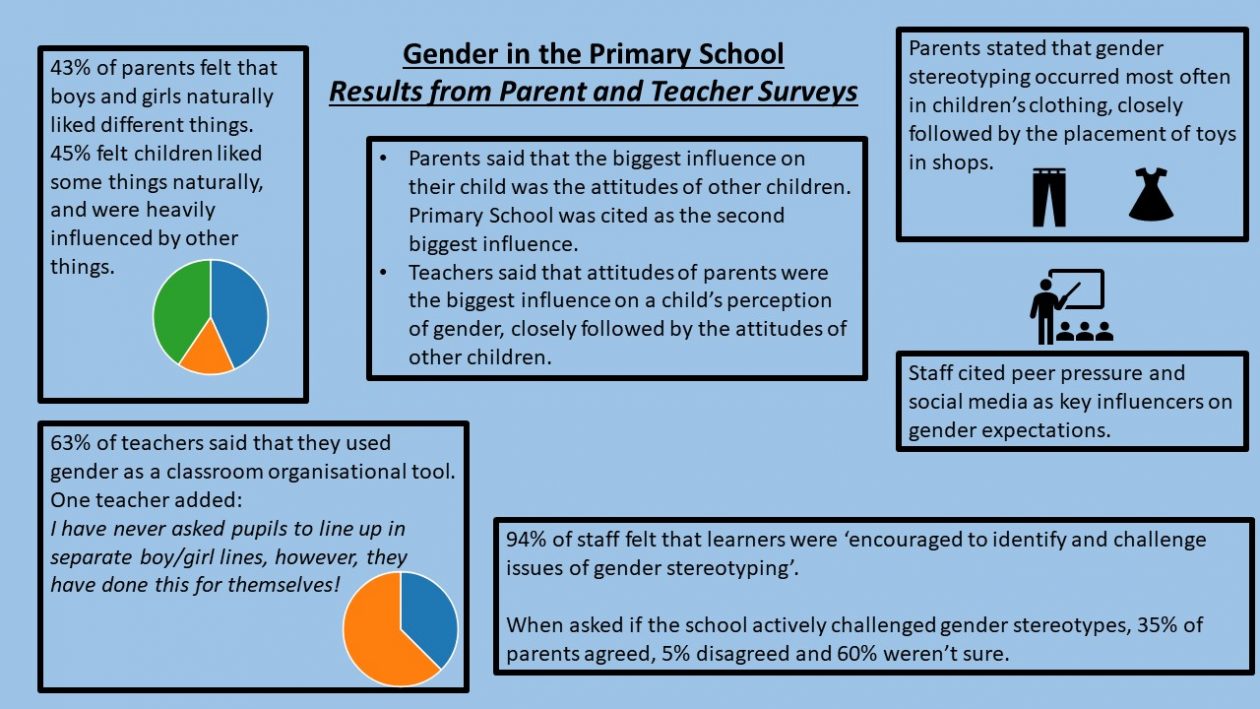


Task 5A -Sharing

Task 4E – How this has impacted my leadership learning
Leadership, to me, means being the catalyst for change and encouraging others – staff, pupils, parents – to reflect upon current practice.
This work has encouraged me to engage with literature and policy to ensure the school’s approach is in keeping with Scotland’s vision for inclusive education.
As this has been a whole school project, I have been focused on ensuring that there is a consistent approach through relevant staff training and sharing of information and resources. I’ve also become acutely aware of the need to collect and collate data in an organised, meaningful way that doesn’t just rely on anecdotal evidence.
Finally, I have been thrilled to engage with pupils in relation to policy and practice and facilitate the opportunity for them to bring about positive change in their school.
Task 4D – The Implications
The school is now engaged in the discussion about gender and what that means for inclusive practice. The staff survey was incredibly helpful for me to gauge if teachers felt their practice had changed in the past year. One teacher commented:
| I feel I’m only beginning to address these kinds of issues and don’t know why I haven’t before. So I feel a bit guilty for that! Especially with the younger ones as I think its so important that they understand these things from early on, discussed in a way appropriate to their age of course. |
Another stated:
I think that teachers probably unconsciously sometimes gender stereotype as we were brought up with but it is good that this current generation are the ones who are more aware of it.
With that in mind, I feel that the next steps would be staff development work around unconscious bias and its impact. We should also explore the representation of gender within our planning, teaching and resources.
The parent survey showed me that we need to be more transparent/explicit about gender inclusion why we promote it and what that means not only for our school but for Scottish education. One parent commented:
Why is Gylemuir/Scottish government forcing this on our children? It seems that it’s is their number one goal.
Another said:
Don’t you have far more important things to consider and look into ? Gender is central to all life and trying to pretend genders aren’t different or that gender traits are wrong is nothing short of embarrassing.
I include these not to be dramatic, but to highlight the fact that there are a range of perspectives on this matter. The general consensus, though, was that the priority should be encouraging pupils not to conform to any kind of stereotype and to be comfortable in their own skin.
The implications of the enquiry thus far are that early intervention is key for children’s perception of gender. The school’s play policy has been updated to be inclusive of all forms of gender expression. Staff are looking critically and the books they use and implementing literature that is inclusive of different types of families, professions and gender expectations. We also need to improve parent engagement with regards to gender inclusion.
Task 4c – What Has Happened?
What forms of evidence tell me what I have learned?
I have captured data from staff, pupils and parents about gender in the primary school – specifically, in our primary school. This whole enquiry is very specific to my own setting and was sparked by the process of working towards achieving the LGBT Youth Scotland Schools Charter Award and being the first primary school in Edinburgh to do so. Therefore, the conversation around gender in my current setting has something of a unique perspective.
What happened for pupils?
I captured pupil views in several ways.
- Discussion with a pupil leadership group that I run:

- Exploration of gender in the early years with particular focus on a P2 class who were presenting an assembly about gender equality (which sadly had to be postponed due to school closures!)

- Delivering an Equalities programme of work to P6 which focuses on the protected characteristics. Unfortunately this was also disrupted by the school closures, but the lesson on gender was delivered and showed me that children understand, and are somewhat weary of being told, that boys and girls can be whatever they want. However, the discussions unveiled that there still was some unconscious bias there.
‘I think people should be whatever they want. But, like, i’d still assume you meant a girl if you were talking about a nurse and i’d maybe find it weird if a boy was a nurse. But I know I shouldn’t.’
What does this tell me?
Early intervention is key in relation to education and gender. I will discuss this more in my next blog post.
Staff and Parent Views
I surveyed staff and parents for their views on gender. Below is a summary and comparison of the key findings.

What does this tell me?
There has been a more prominent discussion of gender and teaching practice, which I am pleased about. It is important to note that there is a discrepancy between staff’s feeling that children are encouraged to identify and challenge gender stereotypes, whilst the majority of parent’s were not sure if this was the case.
Task 4a – What I Did & Task 4b -Why I Did It
What I Did and Why I Did It
- I have surveyed the P7 classes as part of our work on LGBT inclusion. Some of the data gathered is pertinent to gender equality. The reason for doing this was to gain opinions of pupils at the top end of the school in relation to their experiences.
- I had a discussion with our New Arrivals Ambassadors, a pupil group focused on befriending and supporting new pupils, about gender. They are a highly motivated group of pupils who seek to bring about positive change in the school community. I surveyed them because they represent a cross-section of year groups.
- I interviewed pupils in P2 about their approaches to gender stereotypes. This tied in with our work on LGBT inclusion, our Purple Friday celebrations and the pupils’ Health and Wellbeing work.
- I have surveyed parents about gender equality in early childhood and I have surveyed teaching staff about their approaches to gender in the classroom. I felt that it was important to have qualitative data that represented the views of all stakeholders. The questions for teachers were built from IGBE Scotland’s document about gender stereotypes – the reflective questions for practitioners were so, so helpful.
- I have updated the school’s uniform policy to ensure it is inclusive of all forms of gender expression. Fortunately it did not split the uniform into ‘boy’ and ‘girl’ garments anyway but it is now explicitly stated that children may wear what they wish regardless of gender.
What changed and Why?
- My initial plan was to explore football in the playground and the lack of female representation there. Due to the school closures this was no longer possible, but i was able to survey parents and teachers instead which, to be honest, has probably been better as it has provided me with more to think about, although i do feel like I have gone down a ‘rabbit hole’! In terms of policy, there is a plethora of research and paperwork from the Scottish Government which has very clear aims but which has a long, log way to go before it is embedded practice.

